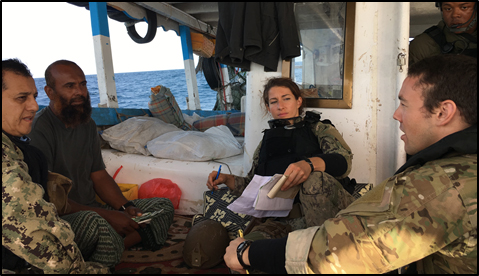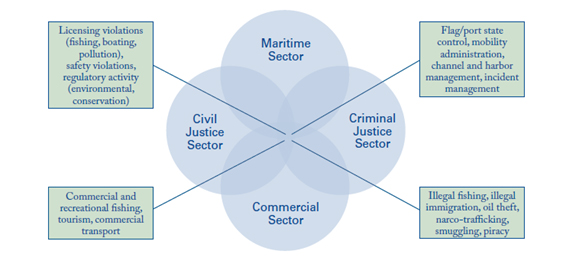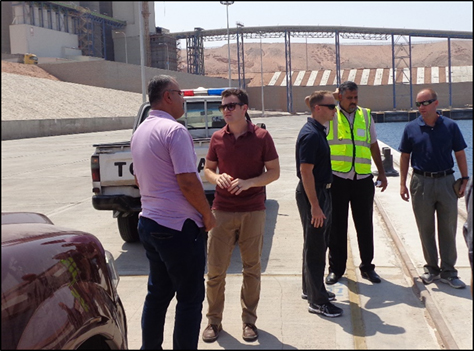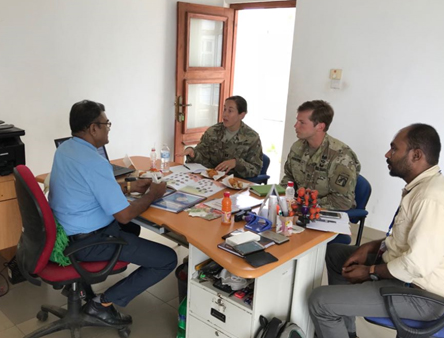Searching for Dry-Land: The Challenges of Maritime Civil Affairs Activities and a Framework for Future Success
Daniel Moriarty and Kevin Peckenpaugh
Introduction
Since 2017, Alpha Company, 83d Civil Affairs Battalion has been tasked with conducting CAA in the CENTCOM AOR in support of Navy Central Command (NAVCENT). This mission has provided both unique challenges and opportunities to the teams that have served on it and has spurred internal discussion over how Army CA forces can best support the Navy through its special set of skills and training. In a dynamic region like the Middle East, A/83d CA has had to adapt its lines of effort multiple times, shifting to better support NAVCENT while also seeking to synchronize efforts with other CA forces across CENTCOM. One of the biggest challenges has been finding the best way to conduct CAA in support of a service primarily focused on deep-water operations. Some in the academic and defense community have called for specific DOTMLPF actions for maritime CAA or CAO, rightly saying that those civil environments where the water meets the land have unique sets of challenges and demand specialized training.[i] But while the need for maritime CAA specialists is generally agreed upon, a distinct capability gap exists, as the Navy’s short-lived Maritime Civil Affairs and Security Training Command (MCAST) deactivated in 2014.[ii] Due to this, the CAO requirement for NAVCENT has been filled by Army Civil Affairs. While a long-term solution to this problem will likely involve a renewed effort by the Navy to develop organic CA forces, in the interim forces like A/83d CA have stepped up. This unique operating environment has provided valuable lessons to the force and can serve as an important study for future CAO, given global population trends.
The world is not just becoming increasingly urban, but also increasingly littoral. Of the world’s top 10 megacities (urban areas determined to have populations of over 10 million people), five are located immediately beside an ocean, with an additional three within 100 miles of an ocean.[iii] These areas are also believed to be likely centers of future conflict.[iv] Adding the maritime domain into this already complex problem set presents additional operational challenges. International shipping commerce, illicit smuggling, and natural disasters like hurricanes are just a few examples of how challenging an operating environment littoral population centers would be for U.S. forces in any context.
This paper will begin by establishing definitions for key terms used throughout it; with a subject matter steeped in both Army and Navy terminology, it is critical to ensure shared understanding. Next, we will discuss first-hand experience with the challenges of maritime CAA, through several examples that have been conducted by A/83d. Following this review, we will discuss a proposed role for CA forces conducting CAA in a maritime environment. Using existing doctrine and academic research as a foundation, our analysis seeks to provide meaningful recommendations on how CA can support maritime forces through targeted CAA in both littoral and maritime environments. Lastly, we will review our analysis and summarize recommendations for the force. This paper is not intended to demand what maritime CAA should or shouldn’t be. Instead, we seek to offer ideas of what maritime CAA could be and hope to generate further discussion on a topic that is increasingly relevant.
Key Terms and Definitions
“Blue-water” refers to naval operations on the high seas and open oceans, where forces must operate for extended periods of time without harboring or interacting with their shoreside counterparts. “Green-water” consists of coastlines that host ports, harbors and littoral populations that require coordination between shoreside and maritime operations. “Brown-water” are the rivers, estuaries, and bays where congestion and restricted travel limits naval vessels’ movement. Brown-water is often managed by shoreside organizations like the Coast Guard or the Navy’s riverine forces.[v]
CAA are activities conducted and assessed by CA forces, that support a commander to integrate indigenous populations, institutions, or unified action partners. These activities include Civil Reconnaissance (CR), Civil Engagement (CE), and Civil Information Management (CIM), the information from which is collated for analysis to develop a shared understanding of the civil common operating picture for commanders, regardless of the Operational Environment (OE). CA forces are designed to operate within the civil component of the OE and must be employed in a way that leverages that civil population to support a commander’s objectives.[vi]
Operational Timeline and Lessons Learned
A/83d CA’s operations in support of NAVCENT have seen great transition between each rotation, each looking to reconcile the initial dichotomy seen between the maritime focus of the Navy and the land-and-human focus of Army CA. A/83d CA took this on in earnest in 2017, assuming control of what had previously been an effort shared between USACAPOC and the 83d during its time under the 85th CA Brigade. From 2017 to 2018, CIM within Bahrain itself was the driving effort. Teams focused their efforts on open-source reporting on social unrest on the small island kingdom and integrated with Naval Criminal Investigative Service (NCIS) to assist in force protection. Through diligent CIM analysis and production, A/83d CA was able to produce significant patterns of life analysis that helped drive NAVCENT security measures. However, one of the challenges to continuing operations within Bahrain was the mismatch of authorities; deployed under USC Title 10, A/83d CA was limited in what activities it could conduct in support of the US Embassy’s Integrated Country Strategy (ICS) in Bahrain, a mission generally more suited for a USC Title 22 CMSE deployment. Instead, efforts began to focus on more regional threats that could be targeted through deliberate CAA.
At the beginning of 2018, developments in the Yemeni Civil War led to a shift in how Civil Affairs supported NAVCENT. As hostilities increased between the Saudi-led coalition and Iranian-backed Houthi forces, the scope and nature of Houthi attacks expanded. Seeking to disrupt Saudi operations, Houthis launched a harbor attack on a World Food Program vessel delivering aid to Al Hudaydah.[vii] This attack, in addition to previous Houthi use of waterborne IEDs triggered a USN increase in Maritime Security Operations (MSO) around Yemen, designed to ensure freedom of navigation through the vital Bab El Mandeb strait. Houthi forces later began launching complex attacks against Saudi oil facilities and platforms which demonstrated a greater capability than previously assessed. Speculation about Iranian support being smuggled into Yemen by maritime routes[viii] further increased the importance of MSO. CATs soon found themselves across the NAVCENT AOR on Navy vessels conducting MSO, integrating into Visit, Board, Search, and Seizure (VBSS) Teams. During these MSO, soldiers would utilize their language capabilities to build rapport with civilian mariners, helping VBSS teams gather valuable information about the human domain.
These civil engagements helped A/83d CA develop a robust understanding of maritime patterns of life. Knowledge of fishing practices, social patterns of seafaring communities, and ethnic make-up of crews all helped paint an accurate picture for NAVCENT of what civil vulnerabilities were present and could impact operations. A/83d CA soon shifted its focus almost entirely to MSO in order to support NAVCENT’s efforts. This presented its own set of challenges. For instance, the rate of MSO missions led to piecemeal taskings of CA Soldiers, disrupting CAT integrity. Additionally, despite the valuable reporting on civilian maritime patterns of life, these engagements did not provide the necessary amount of data to conduct proper Human Network Analysis (HNA), a traditional mainstay of CAO. The analogy was often used of a police force trying to disrupt drug trafficking by pulling over random cars on a highway. Without access to the areas that illicit activities were either destined for or originating from, information gaps would persist and prevent effective HNA or CAO aimed to affect those activities. Additionally, A/83d CA found itself feeding into the broader intelligence enterprise as the civil information gathered from civilian mariners directly influenced MSO. As a result, CATs’ reports from MSO blended with HUMINT reporting, and CA soldiers were often times viewed as HUMINT collectors, contradicting some of the fundamentals of Civil Affairs.[ix] Despite these challenges, the CA Soldiers who participated in these operations were able to serve as force multipliers for NAVCENT.

CA Team Leader engages with a Dhow Master on economic struggles and regional conflict during VBSS operation.
Recent operational changes have forced another re-look at how CA can effectively support the Navy. Planning efforts began to focus instead on littoral environments, primarily focusing on ports and coastal infrastructure that could impact naval operations. In addition, partnerships with the USCG Patrol Forces Southwest Asia were explored and pursued. The USCG supports some of the same governance-focused trends that CAO often focus on. Improving partner nation coast guards’ abilities to interdict illicit activities was chief among these, which USCG executes through the Maritime Engagement Team (MET). Through multiple TSC exercises, CA Soldiers integrated with the MET, incorporating civil engagements and civil information gathering into learning material exchanged with partner nation forces across the AOR. These recent exercises have driven home the importance of understanding the civil environment to partner forces, and will likely continue to be an integral part of CAA in the maritime domain.
Ways Forward
As is generally the case, doctrine can provide a foundation from which to develop a way forward. FM 3-57 details the requirements for effective CAO, listing the variables and considerations that must be taken in when executing civil reconnaissance or civil engagement. For those CA forces conducting CAO in a maritime environment, special analysis must be conducted on how these considerations can manifest themselves in a maritime or littoral environment. One tool to aid in this is the Maritime Security Sector Reform (MSSR). The MSSR was published in 2010 by several U.S. government agencies, including the Department of Defense (DOD), Department of State (DOS), and U.S. Agency for International Development, and serves as a guide to governance, defense, and economic security through a maritime lens.[x] The MSSR offers concrete and directly applicable measures by which stakeholders can assess the capabilities of partner nations to effectively control their maritime territory. The key takeaway from the MSSR is that the same methods used in assessing land-based governance can be applied to maritime organizations or institutions. Utilizing existing tools like the MSSR can help CA forces better plan and target their operations in littoral environments.

An example of the MSSR detailing the intersection between governance and the maritime domain.
CAA must focus and take place in the human domain; namely, locations with significant civilian populations that offer strategic value to ongoing operations. Instead of occurring in the blue-water environments that naval forces operate in, maritime CAA needs to limit its scope to littoral environments that in-turn impact those blue-water environments. Indeed, the commonly used term Maritime Civil Affairs Activities (MCAA) should be replaced with Littoral Civil Affairs Activities (LCAA). LCAA still encompasses the majority of what has been referred to as MCAA, but serves as a reminder to all stakeholders involved that CA forces need to operate in proximity to civilian populations, even if the effects desired exist in the maritime. These littoral areas include ports and port cities affecting regional economic activity, coastal settlements of fishers and traders, and hubs for illicit smuggling.

CA Soldiers meet with operations staff and discuss capabilities during a port assessment in Jordan.
One of the distinguishing characteristics of CA is its understanding of the operational variables (PMESII-PT), the tool used to conduct regional analysis and understand the civil vulnerabilities that drive stability operations. This, along with effective area-studies, is how CA effectively does its homework and postures itself to conduct effective operations.[xi] Applying this analysis, however, to a maritime area of operations, presents unique challenges, as the challenges of maritime smuggling, piracy, and other issues cross international boundaries. Being tasked with conducting tactical CAO across such an AOR is a major obstacle in producing an effective area study. Through successive deployments, A/83d CA produced and utilized area studies for Bahrain and Oman but was challenged to assemble a comprehensive “Maritime Area Study.” Instead, as CA forces conduct maritime or littoral CAA, their efforts should be targeted and limited in geographic scope. This will involve deliberate planning and discussion with supported commands.
This geographic consideration, combined with recent experiences, has shown that integrating CAA with USCG efforts to curb illicit activities and train partner nation coast guards is a natural fit for CA forces. Conducting subject matter expert exchanges (SMEEs) with the MET, A/83d CA was able to build PN capacity across multiple nations, improving these forces’ understanding of civil military operations and improving their ability to gather civil information from civilian mariners. Continuing these episodic engagements allows CA forces conducting LCAA to maintain updated assessment of partner forces operating near littoral population centers. Remaining vigilant of partner force capabilities and limitations is another critical piece to assessing measures of effectiveness in regional lines of effort. Another partner organization that lends itself to maritime/littoral CAA is the Navy Cooperation and Guidance for Shipping (NCAGS). NCAGS is a reservist-led organization tasked with liaising with civilian merchant vessels and shipping companies. Often this involves traveling to select commercial ports in order to meet with operational staff to help de-conflict movements of military vessels and commercial shipping fleets. The potential for NCAGS-CA coordinated efforts is high; as enablers to CAA, NCAGS personnel can serve as subject-matter experts on both port operations and maritime shipping. That, combined with CA forces expertise on the human terrain that impacts those ports or coastal populations, can serve as a framework for much more thorough reporting and analysis. Just as some have called for an alignment of CR with the fundamentals of reconnaissance, so too should partners like NCAGS be viewed as reconnaissance assets that shouldn’t be left in reserve.[xii] Leveraging these partners can amplify the reporting produced by CR in littoral environments.
Lessons should also be taken from the Navy’s short-lived Maritime Civil Affairs Teams (MCATs). During the time they were operational, MCATs implemented several projects and programs that bridged the gap between the human domain and the maritime. One such initiative was the Community Watch on Water (CWOW) program, which sought to improve coastal communities’ self-reporting of suspicious maritime activity. Through CWOW, MCATs were able to identify the key leaders and mobilizers in important coastal communities, and empowered them to support Host Nation (HN) security efforts.[xiii] A/83d CA took the ideas behind CWOW and implemented it within Bahrain, working with the Royal Bahraini Coast Guard to engage fishing communities at-risk of smuggling or violent extremist organization influence. Continuing programs like CWOW elsewhere is another example of using the same fundamentals of CA Methodology to develop effective projects and programs, and apply them in a littoral or maritime environment.

CA Soldiers assess Sri Lankan HA/DR capability to provide USN commanders a better understanding of the HN’s limitations when responding to natural disasters like cyclones.
Recommendations
1. Establish academic courses on maritime infrastructure and littoral economies for Civil Affairs forces: Until such a time that the Navy can provide its own organic CA capability again, Army CA will likely continue to fill that role. To support this, the Navy should develop introductory courses on the many industries that depend on the maritime domain. Utilizing NCAGS specialists or former MCAST personnel to share their experiences and backgrounds can help Army CA better understand their future operating environment. For CA forces tasked with conducting CAA in support of naval forces, receiving this instruction as part of pre-mission training would promote effective planning and communication across branches.
2. Limit operations on blue-water: Despite what may seem like a natural fit, CA forces are not designed for persistent VBSS operations. Engaging with fishermen aboard their vessels can provide some information on patterns of life, but more often than not these individuals’ influence does not expand farther than the edge of their ship. One of the fundamentals taught in the Civil Affairs Qualification Course is the importance of targeting and engaging with key influencers; just as a land-based CAT wouldn’t necessarily target efforts on normal civilians, so too should maritime-focused CATs target those individuals or organizations who hold considerably more influence than a single dhow’s master.
3. Seek persistent engagement with littoral populations: If CA forces are to avoid operating on blue-water, they should then focus instead on green/brown water and the populations that reside beside it. The strategic implications that littoral populations can have on port access and Sea Lines of Communications dictates how naval commanders conduct operations in a blue-water setting. Conducting persistent LCAA can provide these commanders a civil common operating picture to better control their battle space and become a more adaptive force package to respond to future crises.[xiv]
CA Soldiers assess HN HA/DR capability to provide USN commanders a better understanding of the HN’s limitations when responding to crisis
Bibliography
Conflict Armament Research Group. (2016). Maritime Interdictions of weapon supplies to Somalia and Yemen. London: Conflict Armament Research Ltd.
Daniels, M. (2014, May 16). Navy Disestablishes MCAST. Retrieved from US Navy: https://www.navy.mil/submit/display.asp?story_id=81067
Department of State, Department of Defense, USAID, et al. (2010). Maritime Security Sector Reform.
Headquarters, Department of Defense. (2018). JP 3-32, Joint Maritime Operations. Washington, D.C.: U.S. Government Publishing Office.
Headquarters, Department of Defense. (2018). JP 3-57, Civil-Military Operations. Washington, D.C.: U.S. Government Publishing Office.
Headquarters, Department of the Army. (2019). FM 3-57, Civil Affairs Operations. Washington, D.C.: U.S. Government Printing Office.
Headquarters, Department of the Navy. (2015). CS-21, A Cooperative Strategy for 21st Century Sea Power. Washington, D.C.: U.S. Government Publishing Office.
McCarthy, D. (2018). The worst of both worlds: An analysis of urban littoral combat. Sydney: Austalian Army Occasional Paper Series.
Melendez, C. B., & Oh, A. W. (2017). Civil Reconnaissance Concept: Seeking Legitimacy. Fort Bragg: 98th Civil Affairs Battalion.
Reuters. (2018, June 4). U.N. aid boat attacked off Yemen: port authority. Retrieved from Reuters: https://www.reuters.com/article/us-yemen-security-un/u-n-aid-boat-attacked-off-yemen-port-authority-idUSKCN1J01VI
Speers, R. (2014). Shaping the Future of Maritime Civil Affairs: Lessons Learned from the Maritime Civil Affairs Teams 2006-2014. Center for Naval Analyses. Retrieved from Foreign Area Officer Associaton.
Taylor, P. W. (2016). Maritime Civil Affairs. Retrieved from Small Wars Journal: https://smallwarsjournal.com/index.php/jrnl/art/maritime-civil-affairs
United Nations, Department of Economic and Social Affairs, Population Division. (2018). The World's Cities in 2018. New York: United Nations.
End Notes
[i]Taylor, 2016.
[ii] Daniels, 2016.
[iii] United Nations, 2018.
[iv] McCarthy, 2018.
[v] Department of Defense et al., Join Maritime Operations, 2018.
[vi] FM 3-57, 2019, 1-3, 1-4.
[vii] Reuters, 2018.
[viii] Conflict Armament Research Group, 2016.
[ix] FM 3-57, 2019, 1-7.
[x] Department of Defense et al., Maritime Security Sector Reform, 2010.
[xi] FM 3-57, 2019.
[xii] Melendez, Oh, 2017.
[xiii] Speers, 2014.
[xiv] Department of the Navy, 2015.
About the Author(s)
Comments
We are committed to…
We are committed to providing our clients with exceptional solutions while offering web design and development services, graphic design services, organic SEO services, social media services, digital marketing services, server management services and Graphic Design Company in USA.
